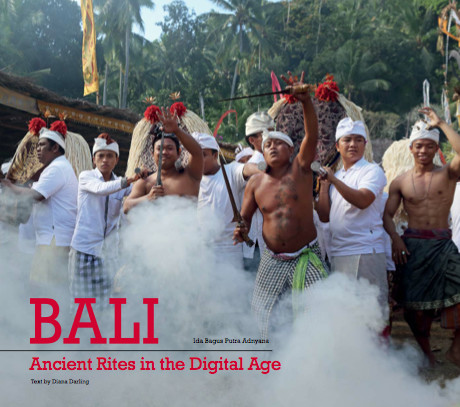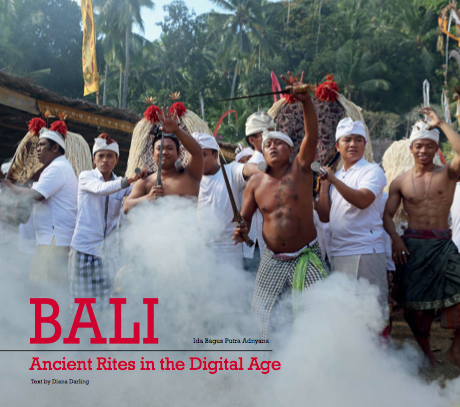
Photographer purely Balinese
The photographer travelled to remote regions of Bali seeking to portray ceremonies that many Balinese themselves have never witnessed.
However he also wished to show how the island was reacting to the modern world. Ida Bagus Putra Adnanya documented the tolerance shown between Hindu Balinese and Balinese Muslims at the usaba dangsil ceremony at the Pura Puseh Merita for example. Meanwhile harmony was also displayed between Hindu Balinese and Kong Hu Cu (Chinese Confucians) at the temple festival at Besakih, Sanur or other important temples on Bali.
The challenge in such photography is colour separation when printing them on glossy paper. Here the publisher has succeeded most of the time, although some images could show more sophisticated colour use and composition in layout.
Many images do attain painterly quality like that of the young boys tooth filing in Tenganan Karangasem or the inner courtyard of the Pura Dalem in Gianyar with towering offerings amidst the mists of burning incense. Others are dramatic in the way processions are portrayed winding their way through verdant rice-fields to a tiny temple in Tirtagangga, an effect probably achieved with a drone camera or small airplane.
Five categories of rituals
Diana Darling, American writer and long-time inhabitant of Bali, is a Jero, honorary title bestowed on the women who marry into a higher caste. She is part of a large Anak Agung family, inhabitant of the banjar of Ubud Tengah, and is therefore qualified to write about these rituals due to her intimacy with the Balinese way of life.
Balinese rituals, as Diana Darling points out, are known for their beauty, richness and occasional extreme violence. Bali, Ancient rites in the Digital Age is an intricately woven interpretation of the ancestral island. The images were taken between 2004 and 2014.
Bali, often called the island of a thousand temples, has long been exposed to the outside world, including the rest of the Indonesian archipelago, and has been featured in glossy magazines inciting visitors to come and spend time on the island. However, the island has had its share of historical tragedies, together with continuing series of earthquakes and violent volcanic eruptions. Sekala and Niskala, the seen and the unseen realms are tangible, but still endowed with magical mystery.
According to Diana Darling, after the photographer and the writer edited the huge number of images together, the text began to flow in a straight-forward manner as the two discussed the topics involved. The detailed explanations of the rituals are clear and concise.
Just as holy water, or tirta, the basis of the Balinese Hindu religion, which is sprinkled in every ceremony by either the high priest or priestly assistants, may now be disappearing from ancient sources, this book witnesses the passing of an age. However, the churning waters of the surrounding ocean still receive the ashes of its inhabitants after the final death ceremonies.
(Price unknown by the reviewer Kunang Helmi)














